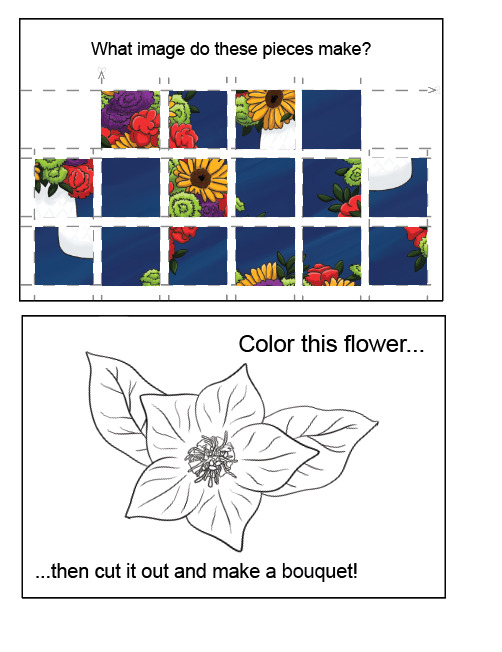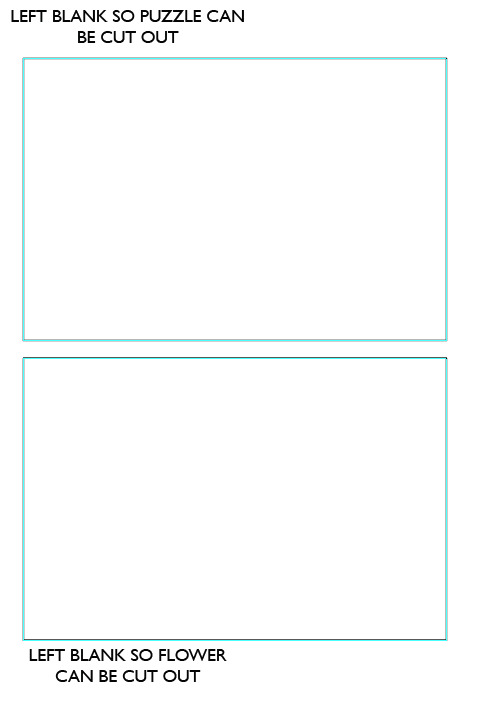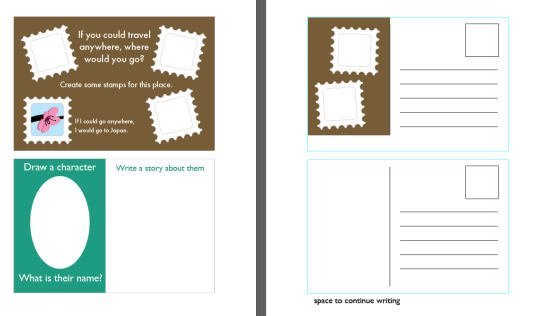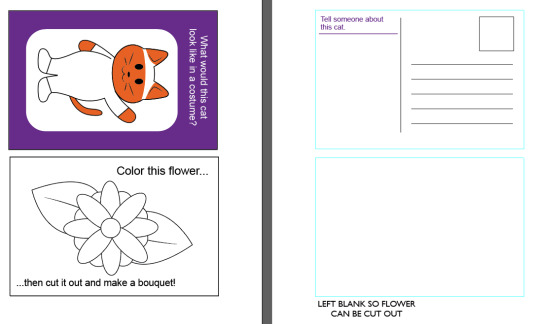A place for notes, sketches, and the general design process of my Typography class projects.
Don't wanna be here? Send us removal request.
Photo
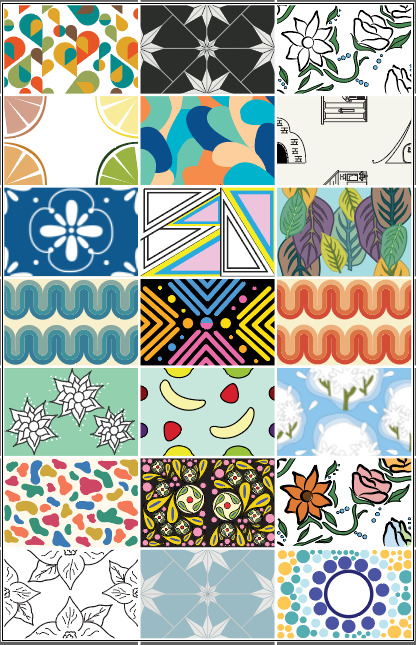

I made two options of the mural card collage for the Elder Postcard Project book. I tried it both with and without the white lines. It looked better with the white lines. 5/9/2020
3 notes
·
View notes
Text
Final Reflection 4/28/2020
I ended up swapping out some of my card design ideas since the original digital roughs. I replaced the cat costume card with the puzzle card idea. I also replaced the color the flower card with a draw a garden card. The cat one, in the style I drew, seemed too simple and childish. I thought of the kinds of activities my own grandmother would like to do if she were using these cards and I came back to my sketch of a puzzle card.
The puzzle card went from a full picture to be cut up later, into pieces already mixed up on the card to be cut up and assembled. The stamp card went from vectors of stamps on a blank table to photoshopped stamps on a passport page background. I added my own answer into the card as well to give an example. The character creation card changed a lot. It went from a simple green card with an elipse to draw in, and I finished it as a create an animal card. The new card has grasses at the bottom, leaves at the top, and leaves on the sides with prompts for potential animal features. On the back, there is a pawprint for the postage marker. The last postcard is a draw a garden activity card. I made a simple continuous line drawing of a flower with a prompt for the user to draw the rest of the garden. The back has a prompt to create more if they wish. The postage spot is another continuous line flower.
I also made a mural card and a sheet of kindness cards. The mural card started as just one simple vector flower to be colored and cut out. I changed it to be a more detailed flower outline, split up so that cards will have to be put together to make the flowers. The user can color the flower and there is a prompt to write between the flowers. The kindness cards went through multiple iterations. I had a sheet of cards based of photographs and some vector cards. I lost the original vector cards and had to recreate them. I scrapped the photo card idea because of the low quality of the photos I had been using. In the kindness cards I played with typography more freely, using some handwritten options I avoided in the postcards.
This project has been really interesting, and I learned a lot about designing for groups of people that may have different physical or cognitive challenges.
0 notes
Text
Midterm Reflection 4/8/2020
For the elder postcard project, I came up with several ideas in my initial sketches such as a picture of a mystical forest and a prompt on the back to tell a story about what happened there. Some other sketches included a picture to be cut into a puzzle or character creation. I wanted to make designs where the user could interact with both sides of the card and customize their experience by allowing them to color or draw on the front and write or continue drawing on the back of the card.
For my rough drafts in Illustrator I chose a sketch where the idea was for the user to think of a place they would like to go and create stamps for it. Another one was to create a character and write about it. A third one is to draw a costume on a cat. The final one is to color in a flower and cut it out to make a wall mural. I am not certain whether or not I will swap any of these designs for my other sketches or if I will continue to push these ideas yet, but I am interested to see where this project goes.
0 notes
Photo



4/28/2020
Final updates on these cards that I have been working on. My other designs have not changed.
1 note
·
View note
Photo
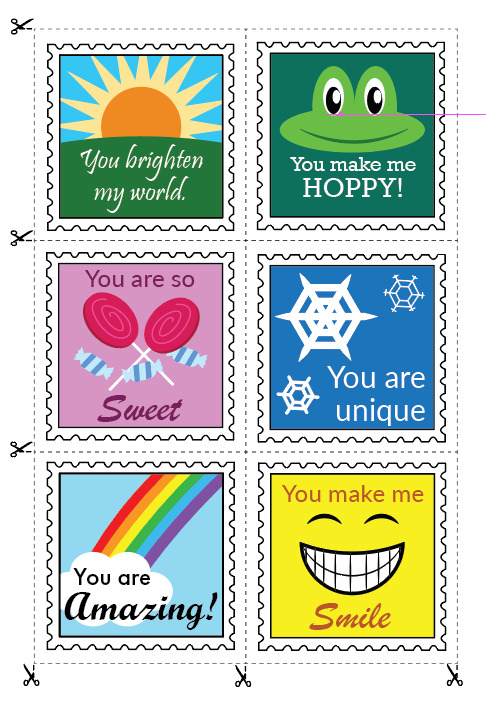
Remade KCards because I lost my other file.
2 notes
·
View notes
Photo

4/24/2020
Update of my Draw a Garden card. I edited the wording on both sides, move front side text to the bottom, and narrowed the line of the back.
4 notes
·
View notes
Text
4/17/2020 Clara Meinen Branding Talk
Clara worked for several ad agencies and is the found of One Sweet Design. She says of brand design, “don’t design for brands, design for the people interacting with brands.”
Clara talked about her design work for multiple wineries like Reverie, Frisinger Family, and Jack. She mentioned specifics for each job and how she crafted the brand based on the experiences they wanted the customers to have.
She says that branding starts with an idea, is developed through research, is articulated by design, and is crafted for consumers. She uses moodboards to help clients to be able to visualize the brands look and feel. Questions like “who?” (who is the brand) and “why?” (why are we doing this) guide the design choices. She says brands should be unique and distinctive. The name should signify what the product stands for.
Lastly she says that nobody will try your product if they do not want to buy into the experience.
1 note
·
View note
Photo
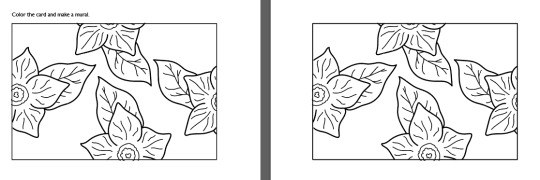
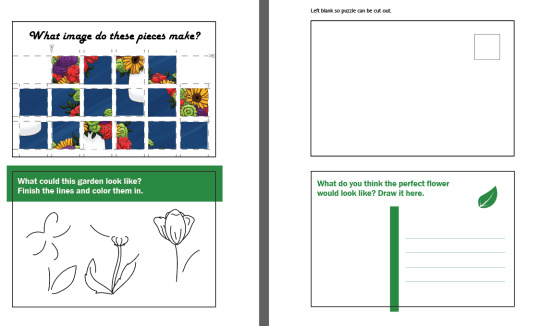
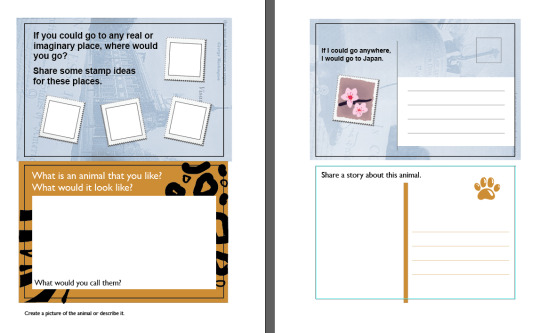
4/23/2020 My latest refinements on my postcards and mural card.
I changed the character creation card to give a more specific goal of creating and naming an animal. I gave a larger space for this and changed the background to animal print. On the back is the new space for writing about the animal and I put a pawprint in the stamp space.
One the stamp card I edited to color of the image in the background. I also changed positioning of elements moving my stamp to the back of the card. I added white space on the stamps for easier writing/drawing.
The puzzle card has remained the same, the stamp square is not in the document, just the screencap.
I changed the Draw a Garden card to be green instead of pink so that it is more gender neutral and encourages men as well as women to use use the card as people of that generation tend to feel restricted by gender roles. I added a leaf in the stamp area.
On the mural card I broke up the flower and changed its positioning to encourage people to put multiple cards together to create a pattern. It is white so that the person can color it in any way they wish.
3 notes
·
View notes
Photo


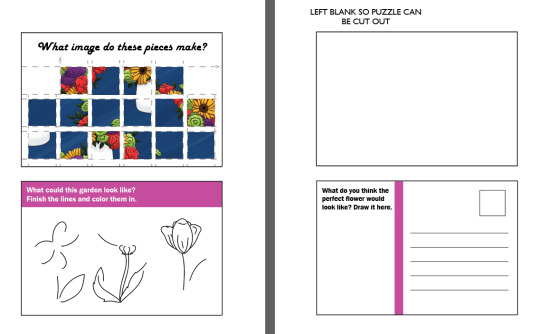
4/22/20
Postcards and Mural card update for Elder Postcard Project.
0 notes
Text
April 6 Readings
Allan Haley –
Legibility – function of typeface design. How easy it is to distinguish letterforms.
Readability – Dependent on how typeface is used. How easily words/blocks of copy can be read.
Counters help define character. , can improve legibility.
Letter shapes can change legibility. 2 story a better than 1 story a. lowercase g in roman shapes better than Helvetica g.
Smaller serifs and lighter weights tend to be more legible.
Transparent type that does not get in the way of the communication process are better.
Sans serif may be best when numbers present.
Emily Gosling –
Typography needs to adapt for dyslexia/etc. might not increase readability, but could lessen stress of reading.
Shapeshifting fonts moves away from static product. More interesting.
Feminist - “Design doesn’t necessarily have to have a feminist concept to do feminist actions,”
Type Tuesday faves were brands. (English sport poster looks epic)
Margaret Anderson –
Assumed that accessible design = industrial design. The exhibition shows though that graphic design is integral to greater awareness of accessible design/diverse experiences.
Multilingual tours, bigger font sizes, etc. so many things can be done. Wheelchair ramp is the beginning not the end.
Access symbol ion this exhibit shows the normal static one, and also an italicized version that shows agency. This version adopted by several cities.
Accessible design not a niche market. Design dismantle the view of disabled and non normative bodies. Reminds disability is diverse/universal. Part of human condition.
Sandy Peckinpah –
Creativity is a way of life not just one form of art. Picasso used many forms of art, not just paint and canvas. Creative living is consistently thinking is new ways.
“every child is born an artist, the trick is remaining one when you grow up” – Picasso. We often lost confidence in our abilities because of those around us.
Keep writing materials around at all times because inspiration often strikes when you don’t have a pen.
Try something new, look at things in a new way.
Be curious, become a sponge.
Give yourself a timeline to pursue your dreams not just “someday”.
0 notes
Text
4/6/2020
Ann Bastings Notes
What inspired you to start timeslips?
Dissertation on how older people can redefine how we think of aging through theater. How they grow/change/learn.
Shift to imagination instead of memory. Gave people access to expression again.
What considerations should be made for disability?
Universal design principles. Red words hard for older to read. Use high contrast, bigger shapes, not too much detail. Don’t ask “whats your favorite?”. “What food makes you happy?” could be easier.
......Didn’t hear question….
TimeSlip typically used in group activities. Invites people into expression. Can’t do that in covid times. Creative tool for people to bridge and bond when elder and caretaker are from different background.
What kind of activities should we focus on/types of experiences?
Think about – marriage of creativity and generosity. Creativity produces a gift. Designs to be used and given away? Where the card could go. Pieces that could be put together into a whole (flower petals? Feathers?)
0 notes
Photo

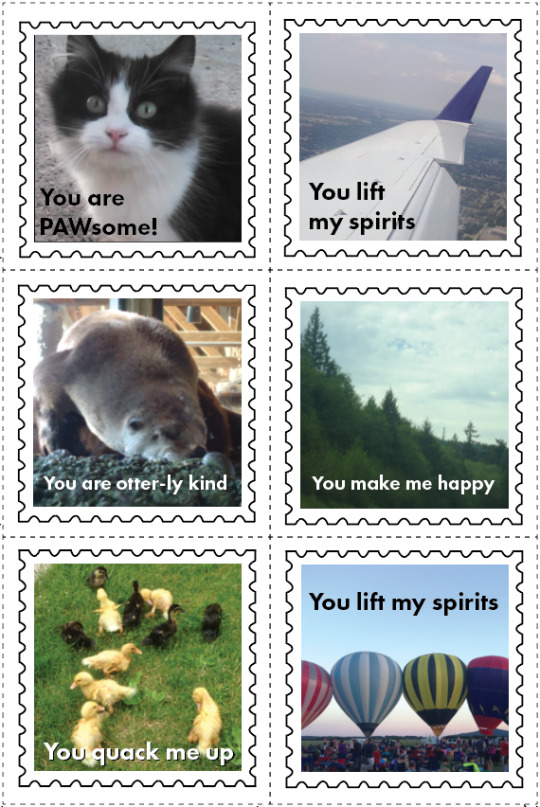
Kindness stamps! I decided to make one set using photographs that I had and one set with vector graphics.
4/6/2020
1 note
·
View note
Text
Research Insights - Project 2 - 4/1/2020
Morgan Johnsen
Research Paper
Typography II
Prof. Beckmann
3/31/2020
The Benefits of Creativity for People with Cognitive Impairment
According to the Center for Disease Control (CDC) in the United States, there are more than 16 million people live with cognitive impairment. This number is expected to rise dramatically as the aging Baby Boomer generation passes at age 65. “An estimated 5.1 million Americans aged 65 years or older may currently have Alzheimer’s disease, the most well-known form of cognitive impairment; this number may rise to 13.2 million by 2050.” (CDC) Cognitive impairments and memory loss often lead to depression for those suffering. Storytelling and activities that foster creativity has been shown to help increase memory capacity and improve the quality of life for patients affected by cognitive impairments.
Depression is common in people who suffer from memory loss. Many people become confused, frustrated, or embarrassed when they are unable to recall memories due to a cognitive impairment such as Alzheimer’s. Episode 447: Forget Me Not of the StoryCorps podcast provides multiple examples of this. In one story Bob Chew asks his wife Jo Ann questions about their relationship. He asks how they met and she cannot recall. She only says, “we somehow got together, and I don’t know how that was.” Jo Ann also mentions that her doctor told her that they no longer want her to cook, which shows that she has a decrease in independence. She says of this, “it bothers me that I’m as I am because I don’t want to be a burden,” and, “I’m sad…. just not having control of everything, my thought, and my actions.” In another story, Teresa Valko tells of how she would talk with her mother who had Alzheimer’s. Valko says that her mother would be embarrassed and confused when she asked questions that relied on memory to be answered. However, Teresa also mentioned that when she asked questions that relied on information that could be gathered right at that moment such as, “what flowers are blooming in your yard today?” that her mother would talk joyfully about her flowers. When she could no longer remember the names of the flowers they would switch to using color instead. While many patients with memory loss suffer depression because of their impairment, the way interactions and questions are posed can make a difference.
Studies have shown that storytelling is beneficial to improving cognitive memory function among people with early-onset or moderate impairments. In a study performed by Federico Batini, Giulia Toti, and Marco Bartolucci, a group of eight subjects with an average age over 82 and all living permanently in a nursing home participated. Students from the University of Perugia read aloud to the group for 60 sessions on a daily basis Monday-Friday for 15-20 at a time which was slowly increased to an hour. The subjects also were given time to talk after each session prompted by a question in an attempt to gauge episodic memory. They started with short simple readings and slowly progressed in the complexity of the stories. Of the six subjects that attended 40 of these meetings or more, significant improvement of immediate memory, delayed memory, and visuospatial perception was shown. For the autobiographical memory episodes, there was a 60% increase in words used from the first session to the last.
Creativity has been shown to be a morale boost for many people, including people with memory loss. A study by Swinnen, De Medeiros, and Pruchno through the TimeSlips project say, “Play…is at the heart of human activity and what gives meaning to life.” At two care facilities in the Netherlands, they made observations of the arts programs people, “learned to play again” and “play often led to expression of joy.” Another study by Houser had ten residents participate in two-hour-long TimeSlips sessions for six weeks. The study found that residents experienced specific benefits. There were also benefits to the staff and the nursing home community. They concluded that the creative projects offered by TimeSlips enhanced the quality of life for the residents.
While many people in the United States are affected with memory loss and cognitive impairments that can cause depression, creative outlets and storytelling have been shown to improve quality of life as well as improve memory and cognitive function. Storytelling and creative activities are a good way to increase morale in nursing homes for people affected by cognitive impairments.
Works Cited
Batini, Federico, et al. “Neuropsychological Benefits of a Narrative Cognitive Training Program for People Living with Dementia: A Pilot Study.” Dementia & Neuropsychologia, Associação De Neurologia Cognitiva e Do Comportamento, 2016, www.ncbi.nlm.nih.gov/pmc/articles/PMC5642403/. Accessed 31 Mar. 2020.
Chew, JoAnn, et al. “Story.” StoryCorps, storycorps.org/podcast/storycorps-447-forget-me-not/. Accessed 31 Mar. 2020.
“Cognitive Impairment: A Call for Action Now.” CDC, 2011, www.cdc.gov/aging/pdf/cognitive_impairment/cogimp_poilicy_final.pdf. Accessed 31 Mar. 2020.
Houser. “TimeSlips Improves Quality of Life.” TimeSlips, 2014, www.timeslips.org/impact/research/3. Accessed 31 Mar. 2020.
Swinnen, et al. “TimeSlips Fosters Play and Joy.” TimeSlips, Mar. 2019, www.timeslips.org/impact/research/6. Accessed 31 Mar. 2020.
0 notes


